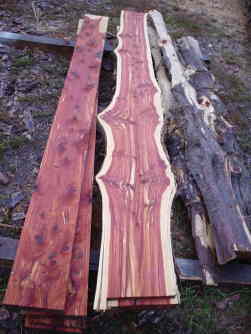Here's Lookin' at Red Cedar
Sawyers discuss red cedar grain oddities, oil characteristics, aroma, and such. August 31, 2005
Question
I have a cedar log that is different - some of the rings are red and some yellow. It looks very pretty when sawed. When the log is sawed, the boards are red with yellow lines in between, running the full length of the board. Has anyone seen this in red cedar? What causes this color change in the rings?
Forum Responses
(Sawing and Drying Forum)
From contributor A:
Those light colored rings are included sapwood. It indicates that the ring didn't form normal (red) heartwood when it converted from sapwood to heartwood. It is very common in Eastern red cedar and occurs in other species, too. People speculate that it may be due to environmental factors (like cold weather), but I don't think anybody really knows.
From contributor K:
Like this?

From contributor D:
While we are talking cedar, what is the white dust that forms on dead stacked cedar, and why does it form there? Also, does anyone have a source of cedar oil?
From contributor K:
The white dust is the oil that crystallizes when it dries. You will see it mostly around the knots. I have no clue how they get the oil out. I do know that if you heat the wood up, it loses its smell-um-good powers.
From contributor D:
If I remember right, the oil is called cedrol. I don't know how they get the oil, either. As a kid, I made some "perfume" with rubbing alcohol and cedar shavings. I'd be willing to bet Mom still has a full bottle on a shelf somewhere. I've heard there is a Texas juniper (eastern red cedar is really a juniper) that is used to get the oil from. The residue is used in some plastic decking.
From contributor H:
We had a mill about 75 miles from us that used to buy cedar logs and would saw the whole log into sawdust, then shoot steam into the sawdust and somehow get the oil out.
From contributor C:
Sawdust or shavings are mixed with water and cooked in a big tank. The steam carries the oil off through a condensation unit that cools the steam and the oil and water separate. You can get about 50 percent of the oil out this way. Kind of like making moonshine.
From contributor J:
Coming from the Pacific Northwest, I've heard that you can get the oil from the green leaves by boiling them and skimming the oil off and if you put this oil in with your laundry soap, the smell gets in your clothes and is a good repellant for mosquitoes.
From contributor G:
I work with cedar on a regular basis. The red part of the tree is considered dead and stores food. The white part on the outside is the living part of the tree (red part supports white part). I think that the white streaks in the wood are known as windshake - damage done from the wind. It is white because it is repairing itself so it will survive.
